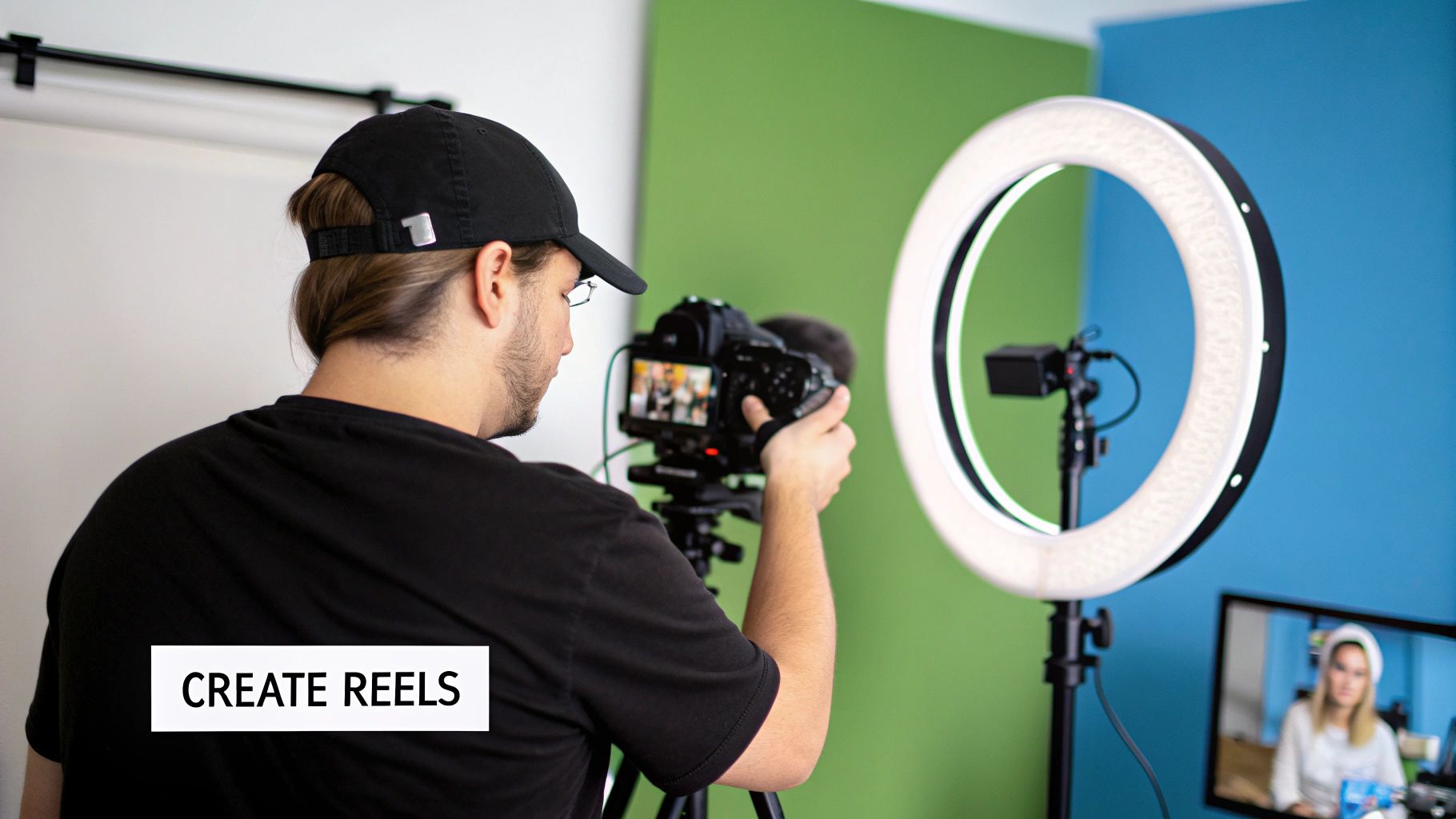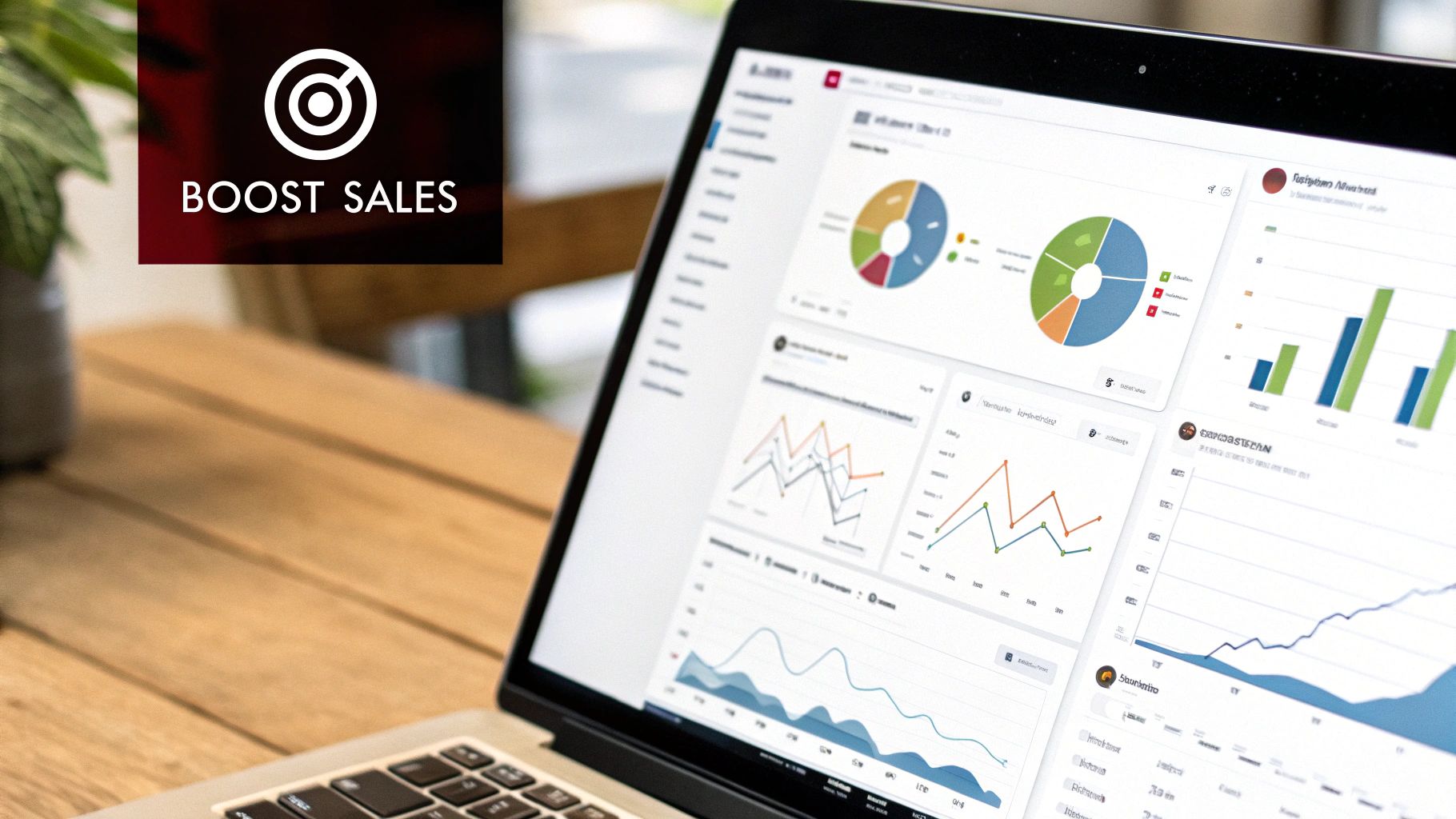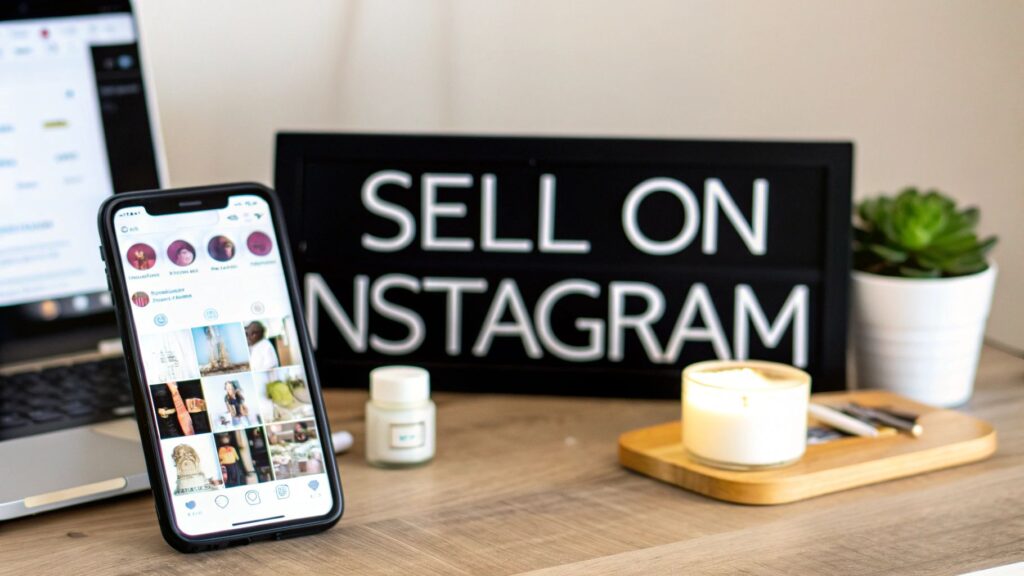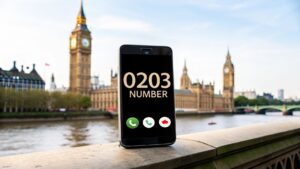Ready to turn your Instagram profile into a sales powerhouse? It's about more than just posting nice photos; it's about creating a streamlined digital storefront. Let's start with the essentials: switching to a Business Account, crafting a bio that converts visitors into customers, and activating Instagram's powerful shopping features.
Setting Up Your Instagram Shop for Success
Before you make your first sale, think of your Instagram profile as your shop window. It needs to be professional, welcoming, and trustworthy. We'll guide you through a few foundational steps that unlock the e-commerce tools built right into the platform. Without these, you're missing out on key opportunities to sell.
The first thing on your to-do list is converting your personal profile to an Instagram Business Account. This is a non-negotiable step if you're serious about selling. It’s a simple change in your settings that gives you access to a whole new toolkit, including Instagram Insights, contact buttons, and the ability to run targeted ads. These are the tools that will power your sales engine.
The Great Debate: Personal vs. Professional Accounts
Wondering why a Professional (Business) account is so important? It all comes down to the features. A personal account is great for sharing photos with friends, but for selling, you need more capability.
Instagram Account Types: What You Need to Know
| Feature | Personal Account | Professional (Business) Account |
|---|---|---|
| Instagram Insights | ❌ No | ✅ Yes (audience demographics, post performance) |
| Contact Buttons | ❌ No | ✅ Yes (email, phone, address) |
| Instagram Shopping | ❌ No | ✅ Yes (tag products, create a shop) |
| Promote/Ad Tools | ❌ No | ✅ Yes (run targeted campaigns) |
| Quick Replies | ❌ No | ✅ Yes (save replies to common questions) |
| Link in Bio | ✅ Yes (one link) | ✅ Yes (one link, but integrates better with tools) |
As you can see, the Professional account is built for commerce. It provides the data and tools you need to understand what's working and refine your strategy.
Optimise Your Profile for Sales
With your Business Account active, your bio becomes your most valuable piece of digital real estate. It's the first thing potential customers see, so it needs to make an impact. In just a few lines, it should clearly state who you are, what you sell, and why they should follow you.
A strong bio does more than just describe; it persuades. You need to highlight your unique selling proposition (USP). Are you a local bakery known for handmade sourdough? Mention it. Do you sell eco-friendly pet toys made in the UK? Make that clear.
Think of your bio as your elevator pitch. Its job is to build instant trust and guide people to the next step—whether that's tapping the link to your shop, visiting your website, or sending you a DM.
This image shows how a well-optimised profile serves as the foundation for your entire Instagram sales strategy.
As you can see, getting your profile right is the crucial first step. It sets the stage for converting casual browsers into loyal customers.
Activating Instagram Shopping
Once your profile looks professional, it's time to activate Instagram Shopping. This feature transforms your feed from a simple photo gallery into an interactive catalogue. It allows you to tag products directly in your posts and Stories, creating a seamless path from discovery to purchase.
Don't underestimate its power. The data is clear: globally, 87% of Instagram users have taken action (like following a brand or making a purchase) after seeing a product. This trend is strong here in the UK as social commerce continues to grow. For a deeper dive into the data, Capital One Shopping has some great insights into how Instagram influences UK shoppers.
Creating Content That Actually Converts
With your shop set up, your Instagram feed becomes your digital storefront. This is where potential customers browse and decide whether to engage with your brand. To successfully sell on Instagram, you need more than just a product catalogue; you need content that captures attention and builds a genuine connection.
It all starts with your visuals. Blurry, low-quality photos simply won't work in today's visually-driven landscape. Your product photography must be crisp, clear, and compelling. But don't just rely on product-on-white-background shots. Weave in lifestyle images that show your products in use.
Selling handmade pottery? Show someone enjoying their morning coffee from one of your mugs. This helps potential customers envision your products in their own lives, turning passive browsing into active buying intent.
Writing Captions That Drive Action
A great image grabs attention, but a well-crafted caption often closes the deal. Think of your captions as a combination of sales pitch, brand story, and customer service. Instead of just listing product features, tell the story behind the product or solve a problem your audience faces.
For instance, a caption for a skincare product could go beyond listing ingredients. It could talk about the feeling of confidence that comes with clear skin or offer a quick tip for a better morning routine.
Crucially, always end with a clear call-to-action (CTA). Tell people exactly what you want them to do next. Whether it’s "Tap the link in bio to shop the collection" or "Comment with your favourite colour," guide them.
Diversifying Your Content Formats
If you're only posting single images, you're missing a significant opportunity. To keep your audience engaged and showcase your products from every angle, you need to mix up your content formats. Each one plays a unique role in the customer journey.
Here’s a quick breakdown of how to use different formats to your advantage:
- Reels: Perfect for product demonstrations, behind-the-scenes glimpses, or entertaining, bite-sized tutorials. Their potential for high reach makes them excellent for reaching new audiences.
- Carousels: Use these multi-slide posts to tell a more detailed story. You could create a step-by-step guide, showcase a product from multiple angles, or share customer testimonials in a visually engaging way.
- Stories: Your go-to for creating urgency and authenticity. Use them for flash sales, interactive polls, Q&A sessions, and sharing user-generated content to build social proof.
In the UK, where Instagram has a massive user base of around 33.4 million people, using these different formats is essential for visibility. Research shows that Reels can reach 122% more users than a single image post, while carousels see 114% more engagement. To get a better grasp of these trends, you can discover more UK social media insights on Avocadosocial.com.
The key is to find a balance. Your feed shouldn't feel like a constant sales pitch. Aim for a healthy mix of promotional, educational, and community-building content. This is how you keep your audience invested in your brand, not just your products.
By blending high-quality visuals, storytelling captions, and a smart variety of content, you create an Instagram presence that doesn't just display products—it builds a community that is eager to buy from you.
Making a Sale: Your Guide to Instagram's Built-In Tools
So, your content is attracting the right people. What's next? You need to make it incredibly easy for them to buy from you. Fortunately, Instagram offers a suite of tools designed to bridge the gap between discovery and purchase. Think of your profile less like a gallery and more like a functional, modern shopfront.
Mastering these features is the key to turning a casual scroll into a sale, often without the customer ever leaving the app.

The real game-changer here is the Shoppable Post. This allows you to tag products from your catalogue directly in your feed posts and Reels. When a user taps the image or video, a shopping bag icon appears with the product's name and price. Another tap takes them to the product page, ready to purchase.
It's all about reducing friction. You capture the impulse buy that might have been lost the moment they had to switch apps to find the item on your website. After all, a high-street shop doesn’t make you guess the prices, and neither should your Instagram.
Curate Your Shop Window with Collections
As you add more products, your shop can become cluttered. This is where Instagram Collections come in. This feature is perfect for organising your digital showroom. Collections let you group similar products, just like you would in a physical store, creating themed lookbooks or curated gift guides.
A fashion brand, for example, could create collections for:
- "Summer Wedding Guest Outfits": A one-stop shop for dresses, heels, and accessories.
- "Work From Home Essentials": A curated list of comfortable and stylish loungewear.
- "Gifts Under £50": Ideal for grabbing attention during holidays like Christmas or Valentine's Day.
By organising your products this way, you make it easy for customers to browse and discover more items they love. It's how a quick look at one dress can turn into a full shopping basket.
Treat your Instagram profile as a dynamic storefront, not just a photo album. Collections help you guide your customer's journey, making it easy for them to find what they're looking for—and perhaps a few things they didn't even know they needed.
Make Your Link in Bio Count
We all know the limitation: Instagram gives you just one clickable link in your bio. With a bit of strategy, you can make it work much harder. Instead of pointing it directly to your homepage, use a "link in bio" tool to create a simple landing page that houses multiple links.
Suddenly, that single link becomes a powerful hub. You can direct followers to your bestsellers, your latest blog post, a newsletter sign-up page, or your main website. It turns a limitation into an opportunity, ensuring every visitor can get exactly where they need to go. This small adjustment is a massive part of selling effectively on Instagram.
You’ve put in the hard work creating beautiful content and setting up a polished Instagram Shop. That’s a huge step, but it’s only half the battle. If the right people don't see your products, all that effort won't translate into sales.
Now, let's explore proven strategies to get your products in front of people who are genuinely interested in buying them. This isn't about chasing vanity metrics; it's about building real connections with an audience that's actively looking for what you offer.
Building a Hashtag Strategy That Actually Works
Hashtags are your best tool for discovery on Instagram. Think of them as signposts that guide potential customers to your profile. However, simply adding popular tags like #shoplocal or #handmade and hoping for the best is no longer effective. To drive sales, you need a smarter, more layered approach.
I always advise clients to think of their hashtag strategy in tiers. You need a mix of broad, popular tags to cast a wide net, alongside highly specific, community-driven tags to attract high-intent buyers.
For instance, imagine you're a small, UK-based business selling handmade soy candles. A tiered strategy would look something like this:
- Broad Tags:
#soycandles(millions of posts) - Niche Tags:
#candleshopuk(thousands of posts) - Hyper-Niche Tags:
#handpouredinscotland(a few hundred posts)
This method ensures you appear in large, active conversations while also dominating the smaller, more relevant ones where your ideal customer is likely to be.
Your goal isn't just to be seen, but to be seen by the right people. Niche hashtags connect you with a smaller but far more engaged audience that is much more likely to convert into a customer.
A solid hashtag strategy is all about balancing reach with relevance. Here’s a simple framework to build a set of hashtags for your product posts.
Hashtag Strategy Tier System
| Hashtag Tier | Post Volume | Purpose | Example |
|---|---|---|---|
| Broad | 500k+ | Casts a wide net for general visibility and brand awareness. | #homedecor |
| Niche | 50k – 500k | Connects with a more engaged, specific audience. | #sustainablehomewares |
| Community | 10k – 50k | Targets dedicated communities and high-intent buyers. | #uksmallbiz |
| Hyper-Niche | Under 10k | Helps you dominate a very specific, low-competition tag. | #shopsmallmanchester |
| Branded | Varies | Creates a unique tag for your brand and user content. | #YourBrandName |
By mixing and matching from these tiers, you give your posts the best possible chance of reaching both a broad audience and the specific people most likely to click "add to basket".
The Power of Collaboration and Social Proof
Let's be honest: sometimes the most powerful marketing comes from other people. Collaborating with others is an excellent way to build trust and get your products in front of entirely new audiences.
This could mean partnering with an influencer whose followers are a perfect match for your ideal customer. My advice? Look for creators with a genuine, authentic connection to their audience, not just a massive follower count. Micro-influencers often deliver far better results.
Another goldmine is user-generated content (UGC). When a customer posts a photo of themselves enjoying your product, it's pure, authentic social proof. It works better than any polished ad ever could. Encourage this! Run a giveaway, create a unique brand hashtag, and make a habit of featuring the best customer posts on your feed and in your Stories. It fosters a real sense of community and shows potential buyers that real people already love what you sell.
A Straightforward Look at Instagram Ads
When you're ready to invest in your sales efforts, Instagram Ads are an incredibly effective tool. Don't be intimidated; you can start with a small daily budget and still see a real impact. The true power of Instagram Ads lies in their robust targeting options.
You can show your ads to people based on their:
- Location: Pinpoint users in specific cities, regions, or even postcodes.
- Demographics: Focus on age, gender, and other key details.
- Interests: Reach people who follow similar brands or have shown interest in your product category.
- Behaviours: Target users based on their recent online activities and purchase history.
This level of precision means your ad spend isn't wasted. You’re having a direct conversation with people who are already primed to be interested in your products.
This is especially important in the UK, where a staggering 82% of consumers use social platforms for product discovery. What's more, 38% of UK shoppers specifically use Instagram to find new items, making it a critical touchpoint in their purchase journey. You can read more about these UK social media findings to see just how vital this is for your brand's growth.
Using Analytics to Boost Your Sales
If you want to grow your sales on Instagram, you have to move beyond guesswork. It's time to get strategic, and that means getting comfortable with your data. Diving into analytics isn't just for data experts; it’s how you truly understand your audience and make smart decisions that lead to real, sustainable growth.
Your best starting point is Instagram Insights, the free analytics tool built into your Business Account. It's packed with information, but the trick is to focus on the few metrics that directly impact your ability to sell.

Key Metrics That Actually Matter
For a moment, let's forget about vanity metrics like follower count. They feel good, but they don't directly translate to revenue. Instead, concentrate on the numbers that reveal how people are actually interacting with your content and your shop.
Here's what you should always keep an eye on:
- Reach: The number of unique accounts that saw your post. Think of it as your content's footprint. High reach is essential for finding new customers.
- Engagement Rate: This includes likes, comments, shares, and especially saves. A high engagement rate signals to the algorithm that your content is valuable, which helps it get shown to even more people.
- Story Taps (Forward/Back/Exit): These metrics reveal how engaging your Stories are. Lots of taps back could mean your content is compelling. A high number of exits suggests it's not holding attention.
- Website Clicks: If you're directing people to an external shop, this is your golden metric. It directly measures how many people are taking that crucial step from your profile to your product pages.
By focusing on these specific data points, you'll build a clearer picture of what your audience wants. For example, if you notice your Reels consistently get double the reach of your static posts, that’s a clear sign to create more video content.
Don’t just glance at the numbers; ask what they're telling you about your customers' behaviour. High saves on a post titled '5 ways to style our scarf' means your audience is looking for practical, value-driven content. Make more of it.
Turning Insights into Actionable Sales Strategies
Once you understand what the numbers are telling you, you can use them to make smarter decisions. This is how you move from simply posting content to building a strategic sales funnel that works.
It can be surprisingly simple. For instance, check your Insights to see the peak times your followers are active. Scheduling your posts for these windows can give them a significant initial boost in visibility and engagement.
See a product-tagged Story getting a lot of sticker taps? That’s your cue to feature that product more prominently in your feed, perhaps in an upcoming Reel or a flash sale. Analytics gives you the power to spot what’s working, replicate your successes, and quickly adjust what isn’t, turning your Instagram into a more effective and predictable sales tool.
Got Questions About Selling on Instagram?
Getting started with Instagram sales can feel like a big step, and it's normal to have questions. You'll learn a lot as you go, but let's address some of the most common hurdles right from the start.
One of the first things people ask is whether they need a full website to make a sale. The short answer is no, not necessarily.
Do I Need a Website to Sell on Instagram?
You can absolutely start selling on Instagram without a website. For many new businesses, Direct Messages (DMs) are the simplest starting point. You can post products on your grid or in Stories, and interested customers can message you to place an order. You can then arrange payment through a straightforward method like PayPal or a bank transfer.
That said, as your business grows, this manual process can become time-consuming. Integrating an e-commerce platform like Shopify streamlines everything. It automates the checkout process, manages inventory, and provides a smoother customer experience. So while a website isn't essential on day one, it's a valuable goal to work towards.
How Many Followers Do I Need to Start Selling?
This is a classic question, but it's based on a common myth. Let's be clear: you don't need a specific number of followers to make sales. It's about the quality of your audience, not the quantity. I’ve seen accounts with 100 highly-engaged followers outsell accounts with 10,000 disinterested ones.
Your goal from the very beginning should be to build a genuine community. Focus on creating real connections and offering value. When people trust you and connect with your brand, the sales will follow naturally, regardless of your follower count.
What’s Better for Sales: Instagram Stories or Feed Posts?
This isn't an either/or situation. Thinking of it as Stories vs. Feed Posts is the wrong approach. The most successful sellers use both for different purposes. They work together to guide a customer from discovery to purchase.
- Feed Posts act as your permanent shop window. This is where you establish your brand's aesthetic. They are excellent for getting discovered via hashtags and serve as a polished, long-term catalogue for your products.
- Stories are for creating a sense of urgency and showing the human side of your brand. They’re perfect for flash sales, getting instant feedback with polls, and driving immediate clicks with link stickers.
Use your feed to showcase your products in their best light. Then, use your Stories to create timely, must-buy moments and connect with your most engaged fans.
Ready to professionalise your customer communications on WhatsApp Business? Business Numbers Direct provides a dedicated virtual number for just £7.99 a month, allowing you to separate your personal and work life without needing a second phone. Get set up in minutes and manage your business comms like a pro. Learn more and get your number today.




